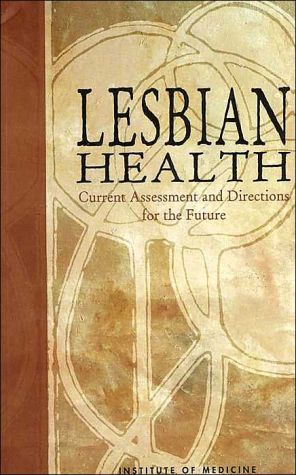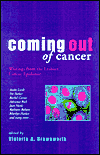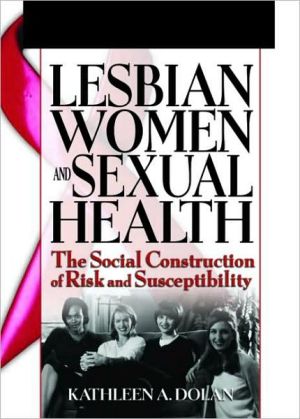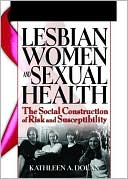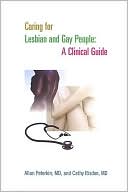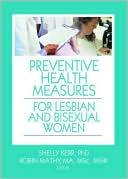Lesbian Health: Current Assessment and Directions for the Future
This book takes a frank look at the political pressures, community attitudes, and professional concerns uniquely affecting the study of lesbian health issues, including: How do we define who is lesbian? Are there unique health issues for lesbians? Are lesbians at higher or lower risk for such health problems as AIDS, sexually transmitted diseases, breast cancer, mental disorders, and substance abuse? How does homophobia affect lesbian health and the funding of research on lesbian health? How...
Search in google:
This book takes a frank look at the political pressures, community attitudes, and professional concerns uniquely affecting the study of lesbian health issues, including: How do we define who is lesbian? Are there unique health issues for lesbians? Are lesbians at higher or lower risk for such health problems as AIDS, sexually transmitted diseases, breast cancer, mental disorders, and substance abuse? How does homophobia affect lesbian health and the funding of research on lesbian health? How do lesbian health needs fit into the health care system and the larger society? What risk and protective factors shape the physical and mental health of lesbians? Marilyn R. Gugliucci This book is a compilation of the research conducted on lesbian health. The editor outlines the challenges of such research for lesbians, researchers, and society. After a presentation of a comprehensive review of the issues, a list of recommendations and interpretations are suggested for mapping out future directions for lesbian health research. The stated purpose is to assess the science base strengths of lesbian health research, review the methodological challenges involved in conducting said research, and to suggest areas for future attention and research. Although women's health is gaining momentum as an area worthy of research, the lesbian subgroup continues to receive minimal attention. Raising the issues pertaining to lesbian health and research in this field is long overdue. The editor's objectives are clearly outlined and achieved. In addition, the contributors demonstrate recognition and knowledge of the psycho-social and societal issues inherent in lesbian cultures which add to the challenges of conducting lesbian health research. The purpose is to help "...health professionals, researchers, policy makers, and others interested in lesbian health, to face the challenges and opportunities of the new millennium." A much stronger appeal needs to be made to lesbians. The text is clear, well organized, and accessible. I view it as empowering to lesbians, in that lesbians can assist in moving the health agenda forward through their participation in research and by supporting policy in this area. The contributors appear to be credible. Credentials are listed in their respective fields, however, there is no statement of philosophy regarding their attitudes of lesbianism.Contributors begin with an executive summary of lesbian health research reviews completed by the Institute of Medicine Committee on Lesbian Health Research Priorities. The summary is comprehensive and lays the foundation for the in-depth information found in the body of the text that includes the health status of and risks for lesbians. Included is a holistic definition of health which makes it clear that health is more than the absence of disease or infirmity. Lesbian health is viewed in the larger context of society and the healthcare system. Contributors include the societal challenges for lesbians and the effect these may have on their health. The strengths of this book are: the combination of education and sensitivity with which lesbian health issues are discussed; the consistency of the contributors' appeal to the reader to realize the impact these issues have on the research; the inclusion of cultural, racial, ethnic, and societal factors on this research; and the complexities of lesbian health at the personal, professional, and societal levels. Features worth noting are the use of tables, figures, and boxes that enhance the content, and an extensive and current bibliography that is organized by topics. A shortcoming is the repetitive information found in the executive summary that is restated in the body of the text. Lesbianism and its health issues will remain a part of all cultures and populations throughout the world. The proactive stance of this research review and the contributors' recommendations are critical to educating people about lesbians' health issues and relevant policies. It is about time that awareness is raised in this under-funded, under-researched, and largely closeted area of women's health. I commend the editor and contributors for their academic as well as humanistic exposition of this review.
LESBIAN HEALTH \ Current Assessment and Directions for the Future\ \ NATIONAL ACADEMIES PRESS \ Copyright © 1999 National Academy of Sciences\ All right reserved.\ ISBN: 978-0-309-06567-2\ \ \ \ Chapter One \ Executive Summary\ Despite growing attention to research on women's health over the past decade, the health problems of some subgroups of women have continued to receive relatively little attention. Lesbians are one such subgroup. Although the body of research on lesbian health is growing, much of the research to date has methodological limitations, such as the lack of appropriate comparison groups, that make it difficult to draw clear conclusions about the health status and health risks of this group of women.\ The Institute of Medicine (IOM) Committee on Lesbian Health Research Priorities was convened in July 1997 to:\ 1. assess the strength of the science base regarding the physical and mental health of lesbians,\ 2. review the methodological challenges involved in conducting research on lesbian health, and\ 3. suggest areas for research attention.\ The study was funded by the National Institutes of Health (NIH) Office of Research on Women's Health, with the Centers for Disease Control and Prevention (CDC) also contributing funding through the NIH.\ A primary charge of the committee was to organize and convene an invitational workshop to examine theseissues. The workshop, held in October 1997, focused on the challenges involved in designing and conducting research on lesbian health, some of the contextual issues that can make it more difficult to conduct such research, and lesbians' risk for particular health conditions including cancer, mental health problems, substance abuse, HIV infection, and sexually transmitted diseases. Lesbians' use of and access to health care services were also discussed. The workshop involved 21 invited speakers, public testimony from more than a dozen presenters, and approximately 50 interested members of the public who also participated in the discussion.\ This report is based on the committee's deliberations and reflects its review and evaluation of the scientific literature on lesbian health and of information presented at the workshop. The committee's conclusions and recommendations, which are outlined here, are presented in detail in the full report. It is important to recognize that this is a workshop-study report with recommendations and that the committee's information gathering and deliberations were thus limited compared to those of a full IOM study.\ The committee identified several important reasons for directing attention to the study of lesbian health issues:\ To gain knowledge to improve the health status and health care of lesbians. Lesbians share many health risks and experiences in the health care system with women in general. For lesbians' health care to be both cost-effective and appropriate, the scope of their health problems must be better understood. Knowledge of areas in which the health of lesbians differs from that of other women may provide insights to improve the health of all women.\ To confirm beliefs and to counter misconceptions about the health risks of lesbians. In the face of little empirical information, there are numerous beliefs, myths, and misconceptions about the health risks of lesbians that can affect their health outcomes. These beliefs are often shared both by health care providers and by lesbians themselves. Some of these beliefs may be true; others are not. These beliefs include perceptions that lesbians do not need regular Pap tests or routine gynecological care, that they do not contract HIV/AIDS, and that there is an epidemic of breast cancer in the lesbian community.\ To identify health conditions for which lesbians are at risk or tend to be at greater risk than heterosexual women or women in general. A large body of epidemiological research has identified factors that place people at risk for health and mental health problems, with gender differences existing for many of these risk factors. However, because information about subjects' sexual preferences has not been collected in these studies, it is not possible to determine whether the lesbians who presumably are included in the samples differed from or were like other women with respect to these risk factors. In fact, some factors assumed to place women at risk for or to protect them against health disorders might not be present at the same levels or operate in the same ways for lesbians. In addition to facing many of the same stressors as heterosexual women, women who self-identify as lesbian may also experience stressors not commonly faced by heterosexual women, such as "stigmatization" both within and outside the health care setting. It is important to identify and understand those factors that are unique to lesbians and their impact on health.\ The committee spent a significant amount of time discussing how to define lesbian sexual orientation. There is no standard definition of what constitutes a "lesbian." In general, sexual orientation is most often described as including behavioral, affective (i.e., desire or attraction), and cognitive (i.e., identity) dimensions that occur along continua (Laumann et al., 1994). Women may exhibit differing degrees of same-sex sexual behavior, desire, or identity, in combinations that vary from person to person. Among the 150 women in Laumann et al. (1994) who claimed at least one of the three dimensions of same-sex orientation (current same-sex desire, current identity as homosexual or bisexual, or same-sex behavior since age 18), Figure 1 shows that almost 60% of them stated desire only, and only 15.3% of them stated all three dimensions of same-sex orientation.\ It is important to note that views of sexual identity and sexual behavior can vary significantly across cultures and among racial and ethnic groups, so it should not be assumed that a lesbian sexual orientation or identity is the same for lesbians of different racial, ethnic, or cultural backgrounds. In particular, it should not be assumed that racial and ethnic minority cultures share views of lesbian sexual orientation identical with those of the dominant culture. The committee notes that there is a dearth of research on racial and ethnic minority lesbians.\ For the purposes of this report, the committee agreed that it should focus on women who have sex with or primary emotional partnerships with women. Because so little research is available about bisexual women and because the degree to which the results of research on lesbians also apply to bisexual women is unknown, the committee considers bisexual women to be a different category or subgroup of women than lesbians for the purposes of this report.\ The committee strongly believes that there is no one "right" way to define "lesbian." Thus, a researcher designing a study on lesbian health should develop measures that gather information about the aspects of lesbian orientation that are relevant to the specific project at hand. Adopting this approach does not avoid the issue of establishing a lesbian definition. Rather, it builds on the need to accept the complexity of sexual orientation and the social context in which it is embedded. In essence, "lesbian" should be defined to reflect the needs of specific research studies, interventions, or programs of care within generally accepted conceptual boundaries, with a recognition of the three dimensions through which sexual orientation is most often defined: behavior, desire, and identity (see Figure 1).\ The committee examined lesbian health from several different perspectives. When examined together, these various approaches can provide a more complete picture of the complexity involved in looking at lesbian health:\ Lesbians in the larger contexts of society, the health care system, and women in general. The contexts in which lesbians live provide a framework for understanding the complexity of their lives. For example, lesbians have historically been the target of prejudice and discrimination, both public and private, and the stigmatization of homosexuality remains widespread in our society. Although many kinds of abuse and discrimination against lesbians have been documented clearly, their impact on physical and mental health still remains to be studied. Lesbians' access to health care services may be affected by such factors as the lack of culturally competent providers and the presence of homophobia among providers, more limited access to health insurance because lesbians cannot share in spousal benefits, and the growing development of managed care systems that may potentially limit lesbians' access to lesbian-friendly providers. Finally, it is important to remember that lesbians confront the same kinds of health risks as do all women.\ Health of lesbians across the life span. All women face developmental challenges as they grow from childhood through adolescence to adulthood and old age. In addition to these predictable challenges, lesbians may encounter special situations associated with their sexual orientation, such as adverse societal attitudes, family rejection, and internalized homophobia. In particular, lesbians must negotiate the process of coming out, or revealing their lesbian identity.\ Specific physical and mental health concerns of lesbians, including risk and protective factors that affect these problems. There is a great deal of speculation, with some attendant evidence, that lesbians may be at heightened risk for some health problems. Large data gaps exist, however, in knowledge about lesbian health, and the population-based information necessary to determine relative health risks of lesbians is not available. The committee examined the available data on a number of possible health risks for lesbians and reviewed what is known regarding lesbians' risk for a variety of health conditions including cancer, cardiovascular disease, sexually transmitted diseases, HIV/AIDS, and mental health and substance abuse problems. Given the limited availability of data that would allow a comparison of lesbian with heterosexual women, the committee did not find that lesbians are at higher risk for any particular health problem simply because they have a lesbian sexual orientation. Rather, differential risks may arise, for example, because some risk or protective factors may be more common among lesbians (e.g., higher rates of nulliparity, which is associated with increased risk for breast cancer), they may experience differential access to health care services (e.g., because of fear of coming out to health care providers), and they are exposed to stress effects of homophobia. Little is known, however, about the specific impact of these risk factors on lesbian health, and even less about any unique protective factors and how they may operate. The committee further notes that misconceptions about risk for certain health problems can negatively affect both the ability of lesbians to seek health care and the treatment itself. For example, it is important for lesbians, just as it is for heterosexual women, to obtain regular Pap tests.\ Conducting research on lesbian health presents numerous challenges. First, lesbians are a population subgroup without a standard definition, and partly because of this, they are a difficult subgroup to readily identify for study. Second, lesbians constitute a small percentage of women and, in addition, are dispersed throughout the population of women, making it difficult and expensive to obtain a population based sample (or probability sample) of lesbians. Third, many in the lesbian community distrust medical research and researchers, which may result in the failure of lesbians to disclose their lesbian orientation in research studies. Fourth, there has been little funding support for research on lesbian health topics. It is not surprising, then, that methodologically rigorous large-scale studies are lacking in this area.\ Although the body of research on lesbian health is growing and there are now a number of well-designed, methodologically sophisticated studies examining these issues, methodological limitations are consistently found in much of the research on lesbian health:\ Inconsistencies in the way sexual orientation is defined, as well as the lack of standard measures, make it difficult to compare findings across studies. Although the committee concludes that there are numerous ways to legitimately define lesbian sexual orientation in research studies, researchers have usually failed to state their definition and their reason(s) for using it.\ The use of small nonprobability samples limits the generalizability of research results. Most lesbian health studies have relied on nonprobability samples. In particular, many studies have used convenience samples-for example, from lesbian bars, music festivals, or gay and lesbian organizations-that are not likely to be representative of the general population of lesbians. Most samples of lesbians, furthermore, have been predominantly white, middle-class, well educated, and between 25 and 40 years old and thus are not representative of other groups of lesbians, for example, from other socioeconomic or racial and ethnic groups.\ The lack of appropriate control or comparison groups makes it difficult to assess the health of lesbians relative to other subgroups of women. Few studies have allowed direct comparisons between lesbians and other subgroups of women (e.g., heterosexual women) by using the same sampling strategies to identify subjects across sexual orientations and by including measures of sexual orientation.\ The lack of longitudinal data limits an understanding of lesbian development and its implications for how to define and measure lesbian sexual orientation. Most existing studies portray cross sections of experience at one point in time and so cannot address compelling questions of behavior, identity, or attraction across time. Prospective, longitudinal studies are essential for understanding the vulnerability, resilience, and well-being of lesbians across their life span.\ Although it can be particularly challenging to design and conduct research on lesbian health for a number of reasons (e.g., the difficulty in identifying a lesbian population subgroup from which to select a probability sample), several strategies can be used to increase the quality of research. The use of computer-assisted interviews can increase disclosure of information, and different sampling techniques can be used to produce more representative study samples.\ In addition to the methodological challenges to conducting research on lesbian health, the committee identified several contextual factors that researchers must also overcome. For example, researchers studying lesbian health may experience discrimination because of the stigma associated with this population. There are relatively few researchers working on lesbian-related issues; thus, researchers can feel isolated, and students conducting lesbian-related research may lack mentors. In addition, funding for research on lesbian health has been limited and difficulties have been reported in publishing research findings.\ Researchers must also establish ties with the lesbian community in order to conduct studies. Pervasive stereotypes about lesbian life, coupled with the limited visibility of this community, create the risk that researchers who fail to familiarize themselves with the community will misinterpret or misunderstand the implications of their results. This undermines the willingness of the community to provide information freely.\ Research on controversial or sensitive topics such as sexual behavior, sexual orientation, or drug use is usually politically sensitive, and researchers interested in doing wide-scale studies of sexual behaviors often face political challenges to the conduct of such research. At the workshop, several possible political responses were identified that could negatively affect the future of research on lesbian health, including legislative denial of the existence of lesbians or failure to recognize lesbian health issues.\ (Continues...)\ \ \ \ \ Excerpted from LESBIAN HEALTH Copyright © 1999 by National Academy of Sciences. Excerpted by permission.\ All rights reserved. No part of this excerpt may be reproduced or reprinted without permission in writing from the publisher.\ Excerpts are provided by Dial-A-Book Inc. solely for the personal use of visitors to this web site. \ \
AcronymsExecutive Summary11Introduction172Lesbian Health Status and Health Risks353Methodological Challenges in Conducting Research on Lesbian Health974Contextual Barriers to Conducting Research on Lesbian Health1355Conclusions and Recommendations155App. ASelected Bibliography on Lesbian Health Research165App. B: Workshop Agenda207App. C: Workshop Participants215App. D: People and Organizations Submitting Testimony223Index227
\ Reviewer: Marilyn R. Gugliucci, PhD(University of New England)\ Description: This book is a compilation of the research conducted on lesbian health. The editor outlines the challenges of such research for lesbians, researchers, and society. After a presentation of a comprehensive review of the issues, a list of recommendations and interpretations are suggested for mapping out future directions for lesbian health research.\ Purpose: The stated purpose is to assess the science base strengths of lesbian health research, review the methodological challenges involved in conducting said research, and to suggest areas for future attention and research. Although women's health is gaining momentum as an area worthy of research, the lesbian subgroup continues to receive minimal attention. Raising the issues pertaining to lesbian health and research in this field is long overdue. The editor's objectives are clearly outlined and achieved. In addition, the contributors demonstrate recognition and knowledge of the psycho-social and societal issues inherent in lesbian cultures which add to the challenges of conducting lesbian health research.\ Audience: The purpose is to help "...health professionals, researchers, policy makers, and others interested in lesbian health, to face the challenges and opportunities of the new millennium." A much stronger appeal needs to be made to lesbians. The text is clear, well organized, and accessible. I view it as empowering to lesbians, in that lesbians can assist in moving the health agenda forward through their participation in research and by supporting policy in this area. The contributors appear to be credible. Credentials are listed in their respective fields, however, there is no statement of philosophy regarding their attitudes of lesbianism.\ Features: Contributors begin with an executive summary of lesbian health research reviews completed by the Institute of Medicine Committee on Lesbian Health Research Priorities. The summary is comprehensive and lays the foundation for the in-depth information found in the body of the text that includes the health status of and risks for lesbians. Included is a holistic definition of health which makes it clear that health is more than the absence of disease or infirmity. Lesbian health is viewed in the larger context of society and the healthcare system. Contributors include the societal challenges for lesbians and the effect these may have on their health. The strengths of this book are: the combination of education and sensitivity with which lesbian health issues are discussed; the consistency of the contributors' appeal to the reader to realize the impact these issues have on the research; the inclusion of cultural, racial, ethnic, and societal factors on this research; and the complexities of lesbian health at the personal, professional, and societal levels. Features worth noting are the use of tables, figures, and boxes that enhance the content, and an extensive and current bibliography that is organized by topics. A shortcoming is the repetitive information found in the executive summary that is restated in the body of the text.\ Assessment: Lesbianism and its health issues will remain a part of all cultures and populations throughout the world. The proactive stance of this research review and the contributors' recommendations are critical to educating people about lesbians' health issues and relevant policies. It is about time that awareness is raised in this under-funded, under-researched, and largely closeted area of women's health. I commend the editor and contributors for their academic as well as humanistic exposition of this review.\ \ \ \ \ Marilyn R. GugliucciThis book is a compilation of the research conducted on lesbian health. The editor outlines the challenges of such research for lesbians, researchers, and society. After a presentation of a comprehensive review of the issues, a list of recommendations and interpretations are suggested for mapping out future directions for lesbian health research. The stated purpose is to assess the science base strengths of lesbian health research, review the methodological challenges involved in conducting said research, and to suggest areas for future attention and research. Although women's health is gaining momentum as an area worthy of research, the lesbian subgroup continues to receive minimal attention. Raising the issues pertaining to lesbian health and research in this field is long overdue. The editor's objectives are clearly outlined and achieved. In addition, the contributors demonstrate recognition and knowledge of the psycho-social and societal issues inherent in lesbian cultures which add to the challenges of conducting lesbian health research. The purpose is to help "...health professionals, researchers, policy makers, and others interested in lesbian health, to face the challenges and opportunities of the new millennium." A much stronger appeal needs to be made to lesbians. The text is clear, well organized, and accessible. I view it as empowering to lesbians, in that lesbians can assist in moving the health agenda forward through their participation in research and by supporting policy in this area. The contributors appear to be credible. Credentials are listed in their respective fields, however, there is no statement of philosophy regarding their attitudes of lesbianism.Contributors begin with an executive summary of lesbian health research reviews completed by the Institute of Medicine Committee on Lesbian Health Research Priorities. The summary is comprehensive and lays the foundation for the in-depth information found in the body of the text that includes the health status of and risks for lesbians. Included is a holistic definition of health which makes it clear that health is more than the absence of disease or infirmity. Lesbian health is viewed in the larger context of society and the healthcare system. Contributors include the societal challenges for lesbians and the effect these may have on their health. The strengths of this book are: the combination of education and sensitivity with which lesbian health issues are discussed; the consistency of the contributors' appeal to the reader to realize the impact these issues have on the research; the inclusion of cultural, racial, ethnic, and societal factors on this research; and the complexities of lesbian health at the personal, professional, and societal levels. Features worth noting are the use of tables, figures, and boxes that enhance the content, and an extensive and current bibliography that is organized by topics. A shortcoming is the repetitive information found in the executive summary that is restated in the body of the text. Lesbianism and its health issues will remain a part of all cultures and populations throughout the world. The proactive stance of this research review and the contributors' recommendations are critical to educating people about lesbians' health issues and relevant policies. It is about time that awareness is raised in this under-funded, under-researched, and largely closeted area of women's health. I commend the editor and contributors for their academic as well as humanistic exposition of this review.\ \ \ 4 Stars! from Doody\ \
